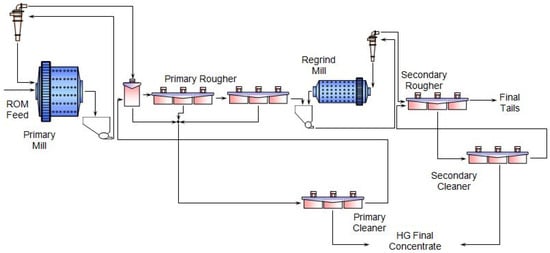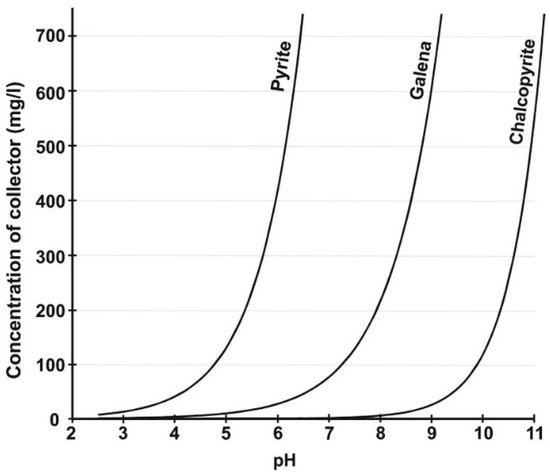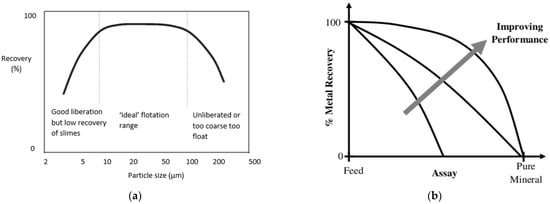Generally, PGMs are closely associated with BMS such that the recoveries of PGMs are closely related to those for the associated BMS. Therefore, work on the biorecovery of BMS can serve as an important guide for the biorecovery of PGMs. Bioflotation of BMS has been carried out using a number of microorganisms that may in turn be used for the recovery of PGMs. This section looks at the biobeneficiation (bioflotation and bioflocculation) of base metal sulphides using several microorganisms reported in previous studies. In terms of the base metal sulphides, the focus will be on those base metal sulphides closely associated with PGMs, i.e., chalcopyrite, pyrrhotite, pyrite and pentlandite.
2.4. Acidithiobacillus ferrooxidans
Separation of chalcopyrite from pyrite under acidic and neutral conditions has been one of the greatest challenges in mineral beneficiation, as these minerals respond to xanthate collectors in a similar way. The addition of
Acidithiobacillus ferrooxidans has been noted to promote the selective flotation of chalcopyrite under acidic and alkaline conditions, leaving behind pyrite [
56]. The bacterium preferentially attaches to the pyrite surfaces, rendering the mineral hydrophilic [
10,
57]. The use of
A. ferrooxidans reduced pyrite floatability by ~70%. Another study [
18] observed depression of pyrite by
A. ferrooxidans, leading to a 50% reduction in pyrite recovery.
In much earlier studies [
58], an 80% reduction in pyrite floatability was reported. The results by Nagaoka et al. [
10] were very interesting considering that
A. ferrooxidans did not have the same depressing effect on minerals such as chalcocite, molybdenite, millerite and galena. It was also found that the recovery of chalcopyrite was not affected by
A. ferrooxidans [
18]. The preferential adhesion of
A. ferrooxidans on pyrite over other sulphides was reported to be due to the presence aporusticyanin located on the surface of the bacterial cell [
59]. However, an earlier study [
60] proposed that the depression of pyrite by
A. ferrooxidans was mainly due to the formation of hydrophilic jarosite on the pyrite surface, rendering pyrite unfloatable. According to Chandraprabha et al. [
2], the depression of minerals is due to buildup of oxidized layers on mineral surfaces as a result of prolonged bacterial interaction. During prolonged bacterial interaction, the elemental S from bio-oxidation is re-oxidized to sulfoxy compounds, which in turn are oxidized to unfloatable sulphates. Some of the sulphates so formed will then dissolve and expose fresh minerals to bio-flotation.
Although the mechanism of pyrite depression by
A. ferrooxidans is not very clear, with various contradicting theories, the depression of pyrite with
A. ferrooxidans is indisputable. On the other hand, it has been indicated that
A. ferrooxidans can also act as a promoter of flotation for some sulphide minerals due to oxidation and subsequent formation of elemental sulphur on the surfaces of minerals [
61]. Therefore, it would be reasonable to propose the use of
A. ferrooxidans in the flotation recovery of PGMs.
A. ferrooxidans has great potential to either depress or float minerals associated with PGMs.
As mentioned earlier,
A. ferrooxidans has been found to be more effective in the suppression of pyrite than NaCN [
62]. The presence of
A. ferrooxidans reduced pyrite recovery from 38.11% to 23.52% and promoted the grade of the target mineral.
A. ferrooxidans can work along with a collector such as potassium isopropyl xanthate, provided a proper conditioning sequence is followed. However, the use of
A. ferrooxidans results in less collector usage [
63]. A conditioning time of 20 min was recommended for effective pyrite suppression [
62]. The conditioning should be done in a medium containing soluble ferrous ions that are used as a growth substrate for
A. ferrooxidans [
64]. Simultaneous interaction of minerals with bacterial cells and collector was also recommended [
56].
Similar results were also observed for the separation of pyrrhotite and chalcopyrite using
A. ferrooxidans [
9].
A. ferrooxidans preferentially attached to pyrrhotite, rendering the mineral hydrophilic such that only chalcopyrite was recovered in the froth phase. The increase in chalcopyrite floatability was due to the formation of elemental sulphur (S
0) due to bacterial activity. It was inferred that the hydrophobicity of chalcopyrite was increased by the S
0 [
9], as well as due the reaction of Cu from the chalcopyrite with the xanthate molecules, as reported in previous work [
65,
66], because the reaction of Cu with xanthate molecules is more likely to have increased the hydrophobicity of chalcopyrite and enhanced the flotation process. Although the formation of S
0 would be expected to increase the floatability of pyrrhotite, this is counteracted by the high density of the hydrophilic cells created after microbe attachment [
9]. Although contact angle values were not given [
9], values of up to 80° are required for high hydrophobicities.
Figure 5 [
9] shows the effects of
A. ferrooxidans on chalcopyrite and pyrrhotite.
Figure 5. Floatability of chalcopyrite and pyrrhotite in the presence of a collector with (solid symbols) and without bio-modification (open symbols). Adapted from Pecina-Treviño et al. [
9].
Although
A. ferrooxidans is acidophilic, it has been proven that it can function as a pyrite depressant at higher pH (of ~8) values [
67]. The increase in the depressing capability of
A. ferrooxidans has been attributed to the increase of bacterial attachment density on pyrite [
68]. In other words, although
A. ferrooxidans loses its oxidative capacity at higher pH, it is still able to attach to pyrite surfaces and cause biodepression. Thus, it might not be necessary to add any acids during the conditioning stage, as
A. ferrooxidans can function as a depressant under alkaline conditions. The collector efficiency, however, can be compromised when
A. ferrooxidans is used in sea water [
68]. It was found that the addition of
A. ferrooxidans to sea water resulted in an increased pyrite contact angle with the collector. The modification of the mineral surface by bacteria may have caused decreased influence of the collector on pyrite than when only sea water was used for conditioning. Although not investigated, collector efficiency must have also been compromised in previous work that was done under similar conditions [
67]. Thus,
A. ferrooxidans suppresses pyrite by inhibiting collector action as a result of increased bacterial density on the pyrite surface.
The depression of pyrite by
A. ferrooxidans under mildly alkaline conditions (pH of 8) has also been observed [
4]. The pH for pyrite depression is close to that reported for PGM flotation, i.e., a pH of 9 [
69]. Although pyrite depression occurred under alkaline conditions, prior surface modification by bacteria was done at a pH of 2, conducive to bacterial activity. It was also found that for effective biodepression of pyrite, considerable time was required for conditioning and to adapt the bacterial culture [
4]. The adapted culture would then be separated from pyrite slurries by filtration and used for bioconditioning of pyrite flotation slurries.
In another study [
70], the use of extracellular polymeric substances (EPS) produced during the early stage of
A. ferrooxidans attachment to minerals was recommended for effective pyrite suppression. EPS are bacterial metabolites that surround the cells and assist with bacterial attachment to mineral surfaces [
67]. Production of EPS is not a function of pH [
67], which plays a contributing role to biodepression by
A. ferrooxidans even under alkaline conditions.
A. ferrooxidans has also been reported to be effective in the flocculation of both pyrite and chalcopyrite, separating them from non-sulphide minerals [
64].
2.6. Leptospirillum ferrooxidans
Leptospirillum ferrooxidans has been reported to be useful in the separation of pyrite and chalcopyrite [
63].
L. ferrooxidans has been observed to preferentially depress chalcopyrite, as it adsorbs more on chalcopyrite than on pyrite. The preferential depression of chalcopyrite is due to higher cell adsorption density [
63]. Because the surface area of chalcopyrite is twice that of pyrite, the higher cell adsorption of
L. ferrooxidans on chalcopyrite than on pyrite has been attributed to chalcopyrite having more surface defects, promoting access to the energy source (Fe) by the bacteria [
63]. However, opposite results were found in later work which showed that
L. ferrooxidans selectively attached more on pyrite than on chalcopyrite, leading to the recovery of chalcopyrite. This work, however, indicated that the growth conditions of the
L. ferrooxidans influence the outcome of flotation results, and that under certain conditions it might be possible to depress chalcopyrite as well. A modified
Leptospirillum HH was used for growing
L. ferrooxidans [
63]. On the other hand, the best separation was obtained when
L. ferrooxidans grew on chalcopyrite [
73]. The contradictory flotation results between the different studies [
63,
73] might be due to their different methods of growing
L. ferrooxidans.
Extracellular polymeric substances (EPS) derived from
L. ferrooxidans were found to be more effective than the
L. ferrooxidans cultures [
73]. Thus, improved chalcopyrite recovery and greater depression of pyrite was achieved with the use of EPS extracted from
L. ferrooxidans. The EPS were produced by growing
L. ferrooxidans on chalcopyrite. It was also found that EPS have better attachment at the mineral surfaces than their parent microorganisms thanks to their higher concentrations of polysaccharides [
67,
74,
75].
The recovery of chalcopyrite in the presence of
L. ferrooxidans has been reported by Diaz-Lopez et al. [
76]. They, however, found that the recovery of chalcopyrite decreased in the presence of pyrrhotite [
76]. The presence of pyrrhotite results in galvanic interactions with chalcopyrite [
76]. These galvanic interactions cause anodic reactions on chalcopyrite surfaces, rendering a degree of hydrophilicity and, consequently, a decrease in chalcopyrite recovery. Some of the pyrrhotite is also recovered in the froth phase because the depressing effect of
L. ferrooxidans is countered by the oxidation of pyrrhotite arising from galvanic interaction with chalcopyrite [
76]. In another study [
77] contrary results were obtained, with the flotation recovery of chalcopyrite increasing in the presence of
L. ferrooxidans due to the formation of hydrophobic species. It therefore appears that the depressive effect of
L. ferrooxidans depends on the xanthate concentration. Certain xanthate dosages result in the counter-creation of species on the chalcopyrite surfaces, resulting in good flotation recoveries. Thus, it is important to optimize the dosage of reagents, as remarked upon in [
62].
2.12. Biobeneficiation of Pentlandite
Although no information has been found regarding biobeneficiation of pentlandite, postulations can be made based on other minerals. For example, the preferential suppression by
A. ferrooxidans of pyrite over non-ferrous galena due to the formation of hydrophilic jarosite [
2] implies that because ferrous pentlandite is likely to form jarosite, it can consequently be depressed by
A. ferrooxidans.
In terms of flocculation, it has also been reported that only sulphide minerals (pyrite and chalcopyrite) were flocculated by
A. ferrooxidans, leaving behind only the non-sulphide species [
64]. Thus, it is likely that sulphide-bearing pentlandite would be flocculated by use of
A. ferrooxidans. Furthermore, it has been reported that any sulphide mineral can be floated if the correct pH can be established [
61]. Therefore, as long as the correct pH is established, flocculation of pentlandite should be possible.
The sulphate-reducing bacteria have been reported to have a dual effect on chalcopyrite, acting as a depressant or promoting flotation [
61]. The dual role for the SRB has been noted to be as a result of the manipulation of the process conditions to either generate a sulphide product or H
2S depressant. It is highly likely that the same reactions can be produced with pentlandite (S-bearing), thus allowing biobeneficiation with SRB.
It is likely that the free EPS derived from mixed bioleaching microbes that were able to separate chalcopyrite and pyrite [
80] could also be used for the biobeneficiation of pentlandite. However, it cannot be postulated whether these would promote flotation or act as a depressant.





